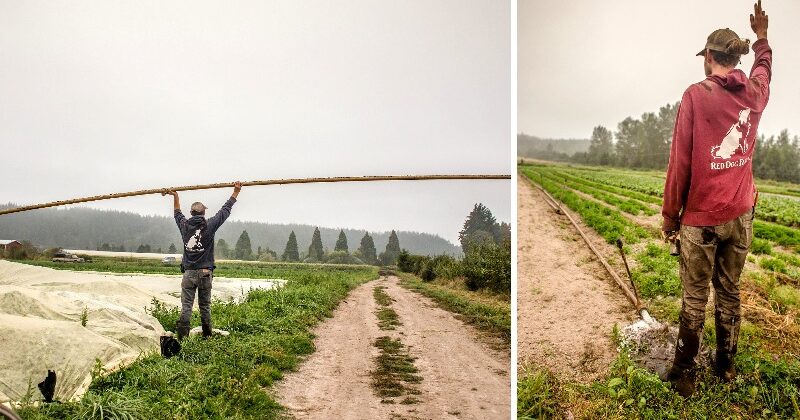Moving Irrigation
We all know that water is an essential part of farming. But knowing about irrigation and seeing it in practice are two different things. As straightforward as it seems to move water from point A to points B, C, and D, irrigation has many moving pieces. Literally. It’s a dynamic world, finicky and imperfect. And a fun one. A silly one. A satisfying one. And beautiful, too.
Our irrigation system uses wells (which, honestly, have always seemed a bit mystical to me). We pump the water, running it through the ground and through long layflat hoses. These layflats connect to a series of pipes which, every day, three times a day, we move across the fields from one bed to another. These pipes are long, with pipettes and sprinklers sticking out one end and a hook for connecting the pipes on the other. To move them, we go pipe by pipe. We unhook them, tipping the pipe upright from one side while walking towards the middle. The pipes drain as we find their balance point. Then, we hoist them over our heads, bounding over beds. Or, for long moves, we balance a pipe or two on our shoulders and try to walk smoothly between the fields.
Sometimes, the wind takes control of the pipe. It rushes around you, catching the pipe, and gently but firmly pushes. The pipe turns slowly, pressuring you to spin too. In these moments, I find I have to pause my stride, root down, and hold the pipe firm. Otherwise, you’re spun into the many shrubs or people walking around you.
Sometimes the plants get tall, like kale. But these areas still need water and so the pipes must be moved. We go through the motions as described above, only to find ourselves tangled in stems and stalks, unable to uncatch the pipes from the plants and unable to put them down. It’s like the kales take them from you, and all you can do is tug and twist and laugh until you break the pipe free.
Sometimes, there are no plants in your path. Instead, you face bed after bed of mud. It might seem easy to have no plants to jump over and no kales to fight for your right to the pipe. But the mud will take you in, deep. Down you go, up to your knees. When you try to take another step, to pull out your leg—sluuuup, your shoe is gone. Lost, deep in the mud. Searching for a lost item in these empty fields means shoving your whole arm—up to your shoulder—into the earth.
There are so many moments like these while moving the pipes across the fields. And in irrigation, there is so much more than pipes. But my favorite moment comes when we’ve laid all the pipes down in a new line. With a partner, we flush the line in order to wash out any dirt or rocks that may have accumulated in the move or while the pipes were resting. One person stands at the spigot. The other all the way across the field. I like standing at this far end. I wave my hand in the air to tell my partner I’m ready for water, and they turn the water on. A gush of air comes out of the pipes, glugging more strongly at each connection joint. I see the water approaching. It sprays out the first sprinkler, then the second. The woosh gets louder. It sprays out the third, the fourth, the fifth. Then, gushing suddenly out of the end of the pipe, the water floods over my feet. I wave my hand again, signaling that the line is flushed. The water slows, transforming from river to trickling stream. The cap goes in and then the sprinklers go all the way on, shooting water in wide, rotating swaths.
I love the sound of the water approaching through the pipe. Somehow, the anticipation makes time feel slow. It’s a moment of pause in a day so full of movement, and the pause for me is made more salient by the motion of the water and air through the pipes. And once the lines are on, shooting water through the air, they seem to move at a different speed too. Gently floating down to the earth, spinning slowly. Casting rainbows and opening up the sweet smells of the dirt.
~Hannah

